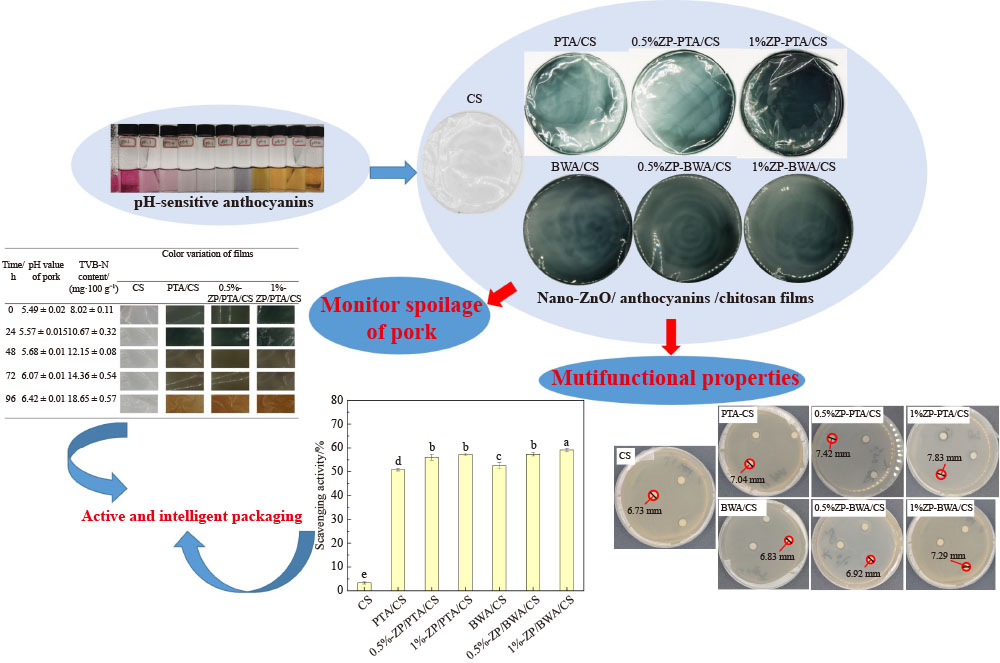1 Introduction
2 Experimental
2.1 Materials
2.2 Preparation of nano-ZnO/anthocyanins/chitosan composite films
Tab.1 Formulation of composite films with different mass fractions |
| Sample | CS/g | Anthocyanins/g | ZnO nanoparticles/g |
|---|---|---|---|
| CS | 2 | 0 | 0 |
| PTA/CS | 2 | 0.1 | 0 |
| 0.5%-ZP/PTA/CS | 2 | 0.1 | 0.01 |
| 1%-ZP/PTA/CS | 2 | 0.1 | 0.02 |
| BWA/CS | 2 | 0.1 | 0 |
| 0.5%-ZP/BWA/CS | 2 | 0.1 | 0.01 |
| 1%-ZP/BWA/CS | 2 | 0.1 | 0.02 |
2.3 pH-sensitivity of anthocyanins
2.4 Characterization of nano-ZnO/anthocyanins/chitosan composite films
2.4.1 Color, thickness and UV–vis spectra of composite films
2.4.2 Morphology and Fourier transform infrared (FTIR) spectroscopy
2.4.3 Color response, moisture content, mechanical properties, and contact angle
2.4.4 Antioxidant properties and antibacterial property
2.5 Application in intelligent packaging
2.6 Statistical analysis
3 Results and discussion
3.1 Original films
Tab.2 Color parameters of films |
| Films | L | a | b | ∆E | WI |
|---|---|---|---|---|---|
| CS | 89.88 ± 0.15a | 2.58 ± 0.16a | –2.72 ± 4.07f | 5.46 ± 0.84f | 88.72 ± 1.80a |
| PTA/CS | 43.86 ± 4.06e | –6.34 ± 0.44d | 3.32 ± 0.28b | 49.56 ± 3.94c | 43.40 ± 4.05de |
| 0.5%-ZP/PTA/CS | 46.28 ± 1.49c | –7.02 ± 0.48e | 1.10 ± 0.34e | 45.07 ± 1.42d | 47.79 ± 1.46c |
| 1%-ZP/PTA/CS | 37.86 ± 1.76f | –6.16 ± 0.21cd | 2.70 ± 0.65c | 55.20 ± 1.65a | 37.49 ± 1.72f |
| BWA/CS | 51.52 ± 1.8b | –6.34 ± 0.26c | 1.52 ± 0.35d | 41.88 ± 1.84e | 51.08 ± 1.84b |
| 0.5%-ZP/BWA/CS | 42.60 ± 1.48e | –5.34 ± 0.17b | 3.24 ± 0.19a | 51.47± 1.35b | 41.89 ± 1.43e |
| 1%-ZP/BWA/CS | 45.3 ± 9.87d | –6.6 ± 0.07d | 3.1 ± 0.25b | 48.18 ± 0.85c | 44.8 ± 0.87d |
Data are presented as mean ± SD (n = 3). Data with different lower case superscript letters in the same column indicate that they are statistically different (P < 0.05). |
3.2 pH sensitivity
3.2.1 Anthocyanins
3.2.2 Nano-ZnO/anthocyanins/chitosan films
3.3 Morphology
3.4 FTIR
3.5 Thickness, moisture content, mechanical properties, and contact angle
Tab.3 Thickness, moisture content, mechanical properties and contact angle of films |
| Films | Thickness/μm | Moisture content/% | TS/MPa | EB/% | Contact angle/(° ) |
|---|---|---|---|---|---|
| CS | 41 ± 1de | 13.98 ± 0.58c | 77.74 ± 1.50d | 12.77 ± 1.32a | 75.8 ± 1.6c |
| PTA/CS | 45 ± 6e | 16.54 ± 0.26b | 80.83 ± 5.58cd | 4.66 ± 0.90bc | 75.5 ± 0.6c |
| 0.5%-ZP/PTA/CS | 51 ± 4ab | 17.13 ± 0.65ab | 82.81 ± 2.79bc | 4.24 ± 0.55bc | 81.0 ± 3.4b |
| 1%-ZP/PTA/CS | 58 ± 7a | 17.86 ± 0.18a | 83.37 ± 3.58bc | 3.71 ± 0.43c | 85.6 ± 1.1a |
| BWA/CS | 45 ± 4bc | 14.62 ± 0.39c | 85.67 ± 2.62bc | 4.90 ± 0.79b | 75.4 ± 0.6c |
| 0.5%-ZP/BWA/CS | 48 ± 4c | 13.85 ± 0.26c | 87.01 ± 2.51b | 4.51 ± 0.54bc | 80.4 ± 0.3b |
| 1%-ZP/BWA/CS | 52 ± 3cd | 14.24 ± 0.57c | 90.60 ± 1.99a | 4.70 ± 1.23bc | 82.0 ± 0.2b |
Values are given as mean ± SD (n = 6 for film thickness, n = 3 for moisture content and contact angle, and n = 6 for TS and EB). Different letters in the same column indicate significantly different (P < 0.05). |
3.6 Antioxidant property
3.7 Antibacterial property
3.8 Application to intelligent packaging
Tab.4 Color variation of films against pH and TVB-N of pork during storage time |
| Time/h | pH value of pork | TVB-N content (mg per 100 g) | Color variation of films | |||
|---|---|---|---|---|---|---|
| CS | PTA/CS | 0.5%-ZP/PTA/CS | 1%-ZP/PTA/CS | |||
| 0 | 5.49 ± 0.02 | 8.02 ± 0.11 | | | | |
| 24 | 5.57 ± 0.015 | 10.67 ± 0.32 | | | | |
| 48 | 5.68 ± 0.01 | 12.15 ± 0.08 | | | | |
| 72 | 6.07 ± 0.01 | 14.36 ± 0.54 | | | | |
| 96 | 6.42 ± 0.01 | 18.65 ± 0.57 | | | | |










